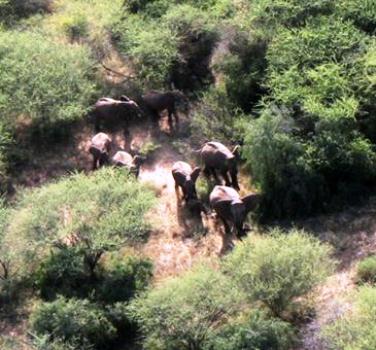Poaching, wildlife trafficking increasing in South Sudan: report
May 25, 2017 (JUBA) – Significant wildlife populations in war-torn South Sudan have so far survived, but poaching, commercial wildlife trafficking, illegal mining, timber harvesting and charcoal production are increasing, the Wildlife Conservation Society (WCS) said a new report.

The aerial survey, according to WCS, was conducted in 2015-16 as part of a project funded by the United States Agency for International Development (USAID) and part of the Great Elephant Census©, funded by philanthropist and Microsoft cofounder Paul Allen.
WCS had previously conducted aerial surveys of South Sudan’s wildlife and protected areas in 2007, 2008, 2009-10 and 2013.
The 2015-16 aerial survey, WCS said in a statement, covered the areas of Boma, Badingilo, Nimule, Southern, and Shambe National Parks, and the proposed Loelle protected area, involving a combination of aerial survey methods covering about 20,845 sq. km.
“The survey confirmed a minimum of 730 elephants in the surveyed zone. However, about 50 percent of previously documented important wildlife areas—including the northern part of South Sudan’s vast wetland, the Sudd—were inaccessible due to conflict, preventing a comprehensive assessment,” partly says the report.
Also, earlier surveys and applied research conducted by WCS and the South Sudan Wildlife Service reportedly estimated an elephant population of some 2,300 in the country prior to the civil war, which began in December 2013, down from about 79,000 in the 1970’s.
Reacting to the report, South Sudan’s minister for wildlife conservation and tourism, Jemma Nunu Kumba acknowledged that surveys were important for the young nation as they show the world that South Sudan remains a home for many iconic wildlife species.
She, however, said the various species have become endangered.
“I want to appeal to the people of South Sudan to take special care in protecting these endangered animals so that the next generation will continue to benefit from their presence. These animals serve and will serve as an import source of ecotourism for the country,” she said.
The USAID South Sudan mission director, Jeffrey Bakken said the U.S government is supporting wildlife conservation in South Sudan, describing it as a priceless resource for the people of South Sudan.
“Our assistance has helped provide employment opportunities, helped resolve local conflicts and promoted knowledge sharing with local communities about the importance and benefits of protecting their wildlife heritage. South Sudan’s wildlife and natural resources can directly contribute to peace and sustainable development,” he said.
The tourism industry may make up a small share of South Sudan’s GDP, estimated at only 1.8% in 2013, but a report by the World Travel and Tourism Council projected that the contribution from travel and tourism to the country’s GDP could grow to 4.1%, come 2024.
But tourism, like many other industries in South Sudan, is still relatively new and is beginning to make a fundamental impact on its own.
Although South Sudan reportedly has the world’s second largest animal migration and thus considered a good place for ecotourism, the lack of infrastructure for tourism and ongoing civil war are considered challenges for the tourism industry in the young nation.
“There is still hope for wildlife in South Sudan even as conflict rages on. But there must be actions taken, including strengthening protected areas, to ensure the protection of South Sudan’s natural heritage which is vital for wildlife and communities alike,” said the WCS president and chief executive officer, Cristián Samper.
“Healthy wildlife populations and well managed Parks can improve livelihoods and security, and stabilize the region,” he added.
South Sudan has 14 national parks or protected areas and world’s second largest animal migration. According to the Times of Malta, the young nation has the “world’s second largest animal migration, an epic migration of the antelopes, but there is not a single tourist to see it”.
(ST)
